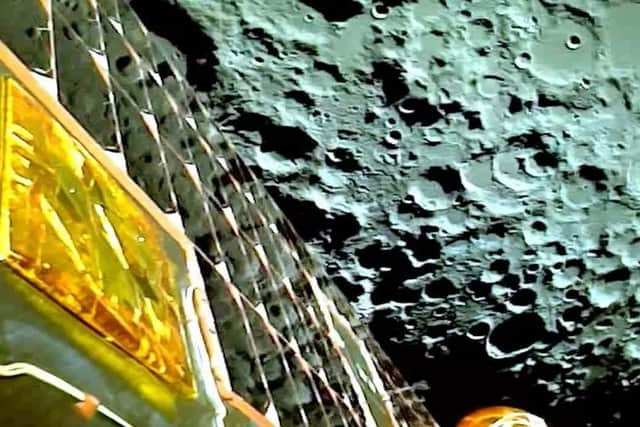Chandrayaan-3: India's moon mission sends new photos of the lunar surface
and live on Freeview channel 276
Chandrayaan-3 is set to safely land on the Moon in the next few days, just after Russia's Luna-25 craft crashed onto the lunar surface.
The Indian Space Research Agency (Isro) released the first images of the moon taken by the Chandrayaan-3 spacecraft on 8 August.
Advertisement
Hide AdAdvertisement
Hide AdThe craft, which entered lunar orbit on Saturday (5 August) has revealed images that show craters on the lunar surface getting larger and larger as the craft draws closer.
Chandrayaan-3's lander and rover are due to reach the surface on 23 August, and if successful India will be the first country to perform a controlled "soft landing" near the lunar south pole.


It will also be the fourth to achieve a soft landing on the Moon after the US, the former Soviet Union and China.
The spacecraft orbited the Earth for 10 days and then was sent into the translunar orbit last Tuesday.
Advertisement
Hide AdAdvertisement
Hide AdIsro wrote on X, formally known as Twitter, “Today, the Chandrayaan-3 mission achieved a crucial milestone with the successful completion of the Lunar Orbit Insertion (LOI),” and that “the health of Chandrayaan-3 is normal.”
This achievement marks the third time in succession that Isro has successfully inserted a spacecraft into lunar orbit.
Isro chief Sreedhara Panicker Somanath has said the agency had carefully studied the data from the crash of Chandrayaan-2, and carried out simulation exercises to fix the glitches in Chandrayaan-3 - which weighs 3,900kg and cost 6.1bn rupees ($75m; £58m).
The lander (called Vikram, after the founder of Isro) weighs about 1,500kg and carries within its belly the 26kg rover which is named Pragyaan, the Sanskrit word for wisdom.
Advertisement
Hide AdAdvertisement
Hide AdNow, the agency will begin to reduce the rocket's speed to bring it to the point to allow for a soft ending.
"A series of manoeuvres have been planned to gradually reduce the spacecraft's orbit and position it over the lunar poles," says Isro.
"After some manoeuvres, the propulsion module will separate from the lander while in orbit. Then a series of complex braking manoeuvres will be executed to facilitate a soft landing in the South Pole region of the Moon on 23 August," it adds.
Once it lands, the six-wheeled rover will eject and roam around the rocks and craters on the Moon's surface, gathering crucial data and images to be sent back to Earth for analysis. The moon's south pole is largely unexplored. The surface area in the shadow is much larger than the Moon's north pole and scientists say it means there is a possibility of water in areas that are permanently shadowed.
Advertisement
Hide AdAdvertisement
Hide Ad"The rover is carrying five instruments which will focus on finding out about the physical characteristics of the surface of the Moon, the atmosphere close to the surface and the tectonic activity to study what goes on below the surface. I'm hoping we'll find something new," Mr Somanath has said.
Comment Guidelines
National World encourages reader discussion on our stories. User feedback, insights and back-and-forth exchanges add a rich layer of context to reporting. Please review our Community Guidelines before commenting.
